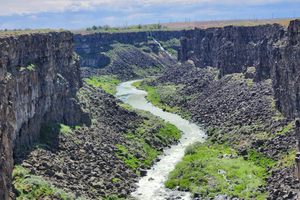
This short but spectacular canyon, a tributary of the Snake River, was originally thought to be formed by sapping, the upward retreat of the cliff at the head of the canyon through undermining by groundwater seepage. Recent research, however, has indicated that a massive flooding event caused by a volcanic eruption some 46,000 years ago is the likely cause.
A temporary river cut the channel, perhaps in a matter of weeks. Although the basalt bedrock is hard, it is heavily fractured and easily broken up by turbulent water flowing with sufficient depth—it would be like taking a firehose to loose dirt. The erosion would be concentrated at the falls down to the Snake River.
The flood event is thought to have resulted from the diversion of the ancient Wood River by lava flows from an eruption upstream. The river originally flowed due west from McKinney Butte, but that course was likely blocked by lava dams, which generated large floods on their collapse. As the flow dwindled, the river settled into its new course and has continued eroding at a considerably more leisurely pace.
A couple of diversion dams, for hydropower generation, were built in the lower part of Malad Gorge in the early 20th century. They are still in use and managed by Idaho Power. A fish ladder, built in 2008, lets trout access the river between the upper dam and the Devil's Washbowl falls upstream.

Post a Comment